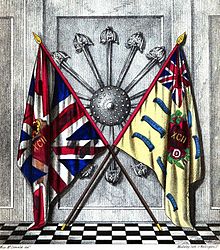92nd (Gordon) Highlanders
| 92nd (Gordon Highlanders) Regiment of Foot | |
|---|---|

Colours of the 92nd (Gordon Highlanders) Regiment of Foot
|
|
| Active | 1794–1881 |
| Country |
|
| Branch |
|
| Type | Highland Infantry Regiment |
| Size | One battalion (two battalions 1803–1814) |
| Garrison/HQ | Castlehill Barracks, Aberdeen |
| Engagements |
Napoleonic Wars Crimean War Indian Rebellion |
The 92nd (Gordon Highlanders) Regiment of Foot was a British Army infantry regiment, raised in 1794. Under the Childers Reforms it amalgamated with the 75th (Stirlingshire) Regiment of Foot to form the Gordon Highlanders in 1881.
The regiment was raised in Aberdeenshire by General George Gordon, 5th Duke of Gordon as the 100th (Gordon Highlanders) Regiment of Foot, in response to the threat posed by the French Revolution, on 10 February 1794. It embarked for Gibraltar in September 1794 and then moved on to Corsica in June 1795. From Corsica a detachment was sent to Elba in August 1796 and the whole regiment returned to Gibraltar in September 1796. The regiment returned to England in March 1798 but was then deployed to Ireland in May 1798 to help suppress the Irish Rebellion. The regiment was re-ranked as the 92nd (Highland) Regiment of Foot in October 1798.
The regiment embarked for Holland in August 1799 and saw action at the Battle of Alkmaar in October 1799 during the Anglo-Russian invasion of Holland, an intervention which was aimed to overthrow the Batavian Republic, a French client republic. It returned home later that month. The regiment embarked for Minorca in June 1800 and then sailed on to Abu Qir in Egypt in March 1801 to take part in the Egyptian Campaign. It saw action at the Battle of Mandora in 13 March 1801. This was a preliminary action before the Battle of Alexandria eight days later on 21 March. That morning, the regiment had been ordered to return to Abukir, having now only 150 effective men, because of illness and casualties sustained. However, on hearing the sound of firing, the regiment saw the commander-in-chief, Sir Ralph Abercromby, passing on his horse and called out to be allowed to return to the line of battle, to which he gave his assent. The regiment sailed for home in October 1801.
...
Wikipedia
